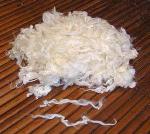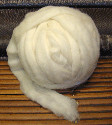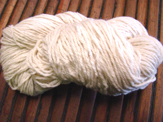Any other questions? Please contact us at: info@birkelandwool.com.
What is the difference between the types of wool you carry?
| Breed |
Fibre Size |
Description |

Borderdale |
33 micron, 100-150mm staple length |
- Coarse wool.
- Popular with home spinners.
- Good for hand-knit yarns and heavy-weight apparels.
|

Coopworth |
35-39 micron, 125-175mm staple length |
- Coarse, long wool.
- Used in heavier apparels and carpets.
- Very good for spinning because of its long length.
- Also good for felting.
|

Corriedale |
30 micron, 75-125mm staple length |
- Fine to medium wool.
- Used for medium-weight outer garments, worsteds, and light tweeds.
- Good for felting.
|

Cross Bred |
Varies |
- Usually coarse.
- Excellent for spinning, great for beginners.
|

Merino |
20-22.8 micron, 65-100mm staple length |
- Very soft, fine wool.
- Best for next-to-the-skin wool.
- Easiest to felt. Good for making thin, floppy felt.
- Used in quality woolen and worsted fabrics.
|

Perendale |
31 micron, 100-150mm staple length |
- Good for felting.
- Makes stiffer, cushy felt.
|

Polwarth |
22-22.5 micron, 75-110mm staple length |
- Fine wool used in worsted fabrics, knitting yarn and apparels.
- Polwarth is a type of merino, but it is stronger because the staple length is longer.
- Excellent for felting. Good for felting projects with children because it felts fast.
|

Shetland |
34 micron |
- Coarse wool.
- Good for felting and spinning.
|
T29 (Southdown/
Perendale) |
50/50 blend |
- Good for felting.
- When wet felted it can sometimes look wavy.
- It is a blend of Perendale wool and Southdown wool, not a mixed breed sheep.
|

Southdown |
23-28 micron, 50-75mm staple length |
- Not good for felting on its own, but good if mixed with other types.
- Great for stuffing, very springy and dense. It will wiggle through fabric if it is stuffed inside fabric that is not woven tight enough.
|
Images from New Zealand Sheep and Their Wool by the New Zealand Wool Board, 1980. Shetland photo from the Shetland Sheep Society.
For more information on different breeds of sheep, we have found this database useful: Oklahoma State University's Department of Animal Science - Sheep Breeds
What is the difference between fleece, batt, roving, sliver, and yarn?
- Fleece
- Washed wool which is uncarded
- Fleece contains natural curls
- Batt
- Washed and carded wool
- The wool is carded into a large, flat sheet called a batt
- Sliver (also called Roving)
- Washed and carded wool
- The wool is carded into long, thick strands
- Sliver can be easily fed into a spinning wheel for spinning into yarn
- Yarn
- Washed, carded, and spun wool
- Yarn can be very thick or very thin, but unlike sliver it is twisted (spun) and usually plied together
 Loading... Please wait...
Loading... Please wait...












